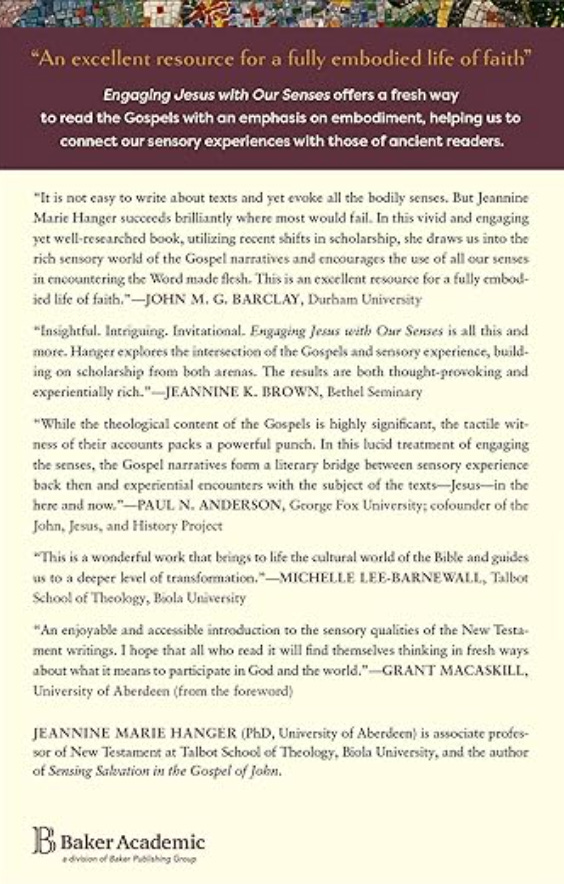Engaging Jesus with Our Senses
Here's my review, first published in the Englewood Review of Books, of a remarkable and original new book in the field of New Testament studies
My review of Janine Hanger’s Engaging Jesus With Our Senses (Baker Academic, 2024) appeared this week in the Englewood Review of Books…
Paperback: Baker Academic, 2024
Buy Now: [ BookShop ] [ Amazon ] [ Kindle ]
Reviewed by Douglas Brouwer
Engaging Jesus with Our Senses is a remarkable and in many ways an original book. Much of biblical scholarship today, especially New Testament studies, still seem strongly influenced by Enlightenment rationalism leading– as most seminary students know– to a higher-critical approach to the Bible. The result is often that we understand a great deal about the historical and cultural context in which the Bible was written, but less of its spiritual and theological significance.
Jeannine Hanger’s new book, which grew out of her recent PhD work at the University of Aberdeen, is hardly anti-rational, but instead offers a fresh, engaging, and thoughtful alternative, which she calls “bridging the mind-body divide through an openly sensory approach.”
To be clear, Engaging Jesus is not a popularized version of her dissertation; it’s an adaptation and significant expansion of that work. What Hanger sets out to do is to read the four gospels—to engage Jesus, as the title puts it—by moving from “cognitive knowledge” about Jesus to an “embodied experience.” In her words, “to go from hunger to nourishment is more than mere cognitive knowledge; it’s an embodied experience that we know, because we know this nourishment in our guts, literally.”
I found the approach so original and unexpected that I had to pay careful attention as I read. Hanger’s argument requires a close reading, especially in the opening chapters as she lets the reader know what she is about to do. After setting up the argument, Hanger then structures the book around the five senses: taste, sight, hearing, smell, and touch (in that particular order, for reasons Hanger explains at length).
So, to give an example, in the chapter on taste, Hanger argues that taste is “a category of knowledge unlike any other.” And then she reviews the many examples in the synoptics, as well as the Fourth Gospel, where we read about people tasting and feasting and dining together. “The wedding in Cana,” she notes, “is one of the few scenes in John in which the word ‘taste’ appears,” but the story makes clear that Jesus provides “an abundant amount of the best wine,” recalling the eschatological feast in Isaiah 25:6-8. The sense of taste in this story, Hanger argues, signals the arrival of the kingdom.
Some gospel stories, which I have read often over the years (and of course preached), seemed to come alive or take on unexpected meaning because of Hanger’s unique approach. I had never considered Jesus’s baptism to be such a rich “visual and auditory” experience. My training, for example, encouraged me to think theologically about what was happening at the Jordan River that day—whether Jesus really needed to be baptized and what it meant that John administered it. And though I am grateful for those insights, and still see their importance, Hanger reveals another, perhaps even richer layer of meaning: “The Spirit descending on Jesus and the divine voice together convey God’s affirmation of Jesus’s sonship.” Hanger reminds us at this point of Isaiah 42:1 where God says, “Here is my servant, whom I uphold, my chosen one in whom I delight; I will put my Spirit on him, and he will bring justice to the nations.”
I recommend this book for its freshness and originality, but I wondered as I read how it will be used. Pastors will certainly be able to make use of it and find ways to make old stories take on new meaning. Classes such as the ones Hanger teaches at the Talbot School of Theology will embrace it eagerly. But I wondered if book discussion groups and other adult classes would be able to make sense of it (so to speak). I hope they give it a try.
Tellingly, there are questions for further reflection after each of the chapters on senses—“tasty bites for further nourishment” follows the chapter on the sense of taste, and “snippets of sound to lead the way” follows the chapter on hearing—but these questions are addressed to individuals, not groups. And they invite meditation, not discussion.
As for Hanger’s conclusion, I am in agreement: “Let’s do more than read about Jesus; let’s reach out and sense him.”






Thanks for sharing this review!!!
book ordered!